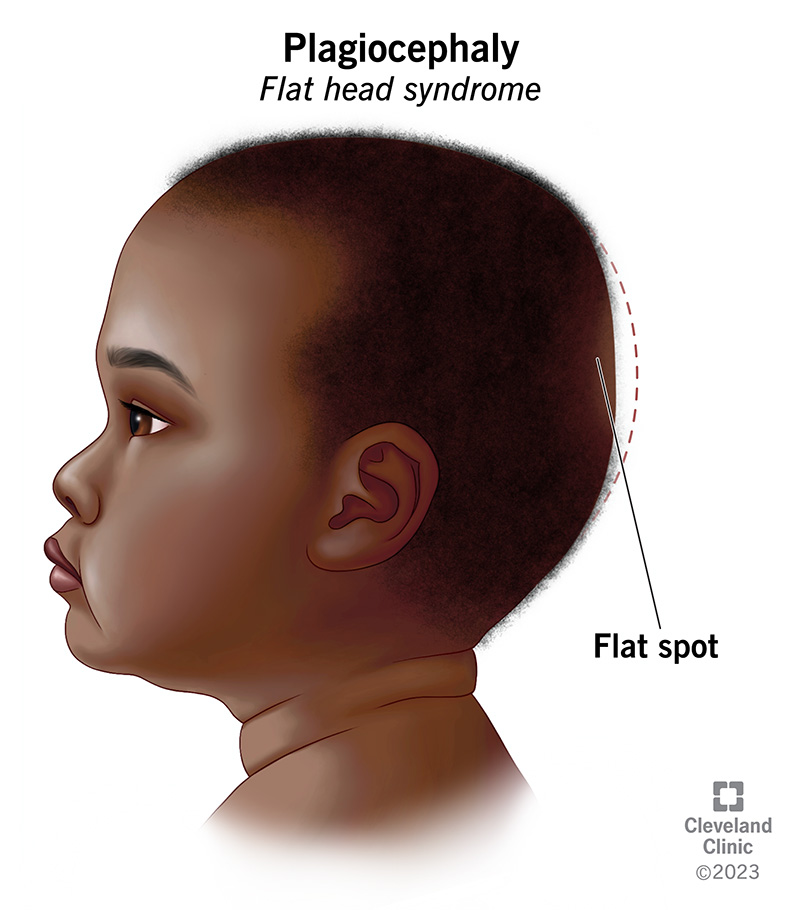“Plagiocephaly” is an umbrella term used to describe different types of skull deformations, including flat head syndrome, or positional plagiocephaly. Flat head syndrome is a condition in which your baby’s head is misshapen or develops a flat spot, making their head look like a parallelogram from above.
Advertisement
Cleveland Clinic is a non-profit academic medical center. Advertising on our site helps support our mission. We do not endorse non-Cleveland Clinic products or services. Policy

Positional plagiocephaly (pronounced “play-jee-oh-seh-fuh-lee”), or flat head syndrome, is a condition in which your infant’s head develops a flat spot or is misshapen. It usually affects one side of your baby’s head. This can make your baby’s head look abnormal or asymmetrical.
Advertisement
Cleveland Clinic is a non-profit academic medical center. Advertising on our site helps support our mission. We do not endorse non-Cleveland Clinic products or services. Policy
Parents and caregivers should always put babies to sleep on their backs to prevent sudden infant death syndrome (SIDS). But when infants spend a lot of time on their backs, they may develop flat head syndrome. Repositioning techniques can help reduce the appearance and effects of flat head syndrome.
Positional plagiocephaly, sometimes called deformational plagiocephaly, is the most common type of plagiocephaly. There are other types, including:
According to studies, positional plagiocephaly occurs in up to 50% of babies and it’s usually very mild.
Plagiocephaly symptoms vary based on type and level of severity. Positional plagiocephaly symptoms may include:
Advertisement
Babies’ skulls are soft and somewhat moldable. And infants sleep on their backs for many hours every day. While sleeping, they may consistently turn their head to one side.
If your baby sleeps with a turned head too often, the same section of their head may rest on a surface frequently. Regular pressure can flatten that section of your baby’s soft head.
Premature babies are more likely to have flattened heads because their skulls are less developed. They also spend more time lying down in the hospital and at home.
Some babies with plagiocephaly also have a condition called congenital muscular torticollis. It occurs when tightening in your infant’s neck muscles causes their head to twist and rotate to one side. Torticollis can be treated with physical therapy.
Other factors that increase your baby’s risk for plagiocephaly include:
You may notice the flattening of your baby’s head by 6 to 8 weeks of age. Your baby’s healthcare provider can diagnose plagiocephaly visually by looking at your baby and observing the flattening of their head. Your child’s provider doesn’t need any tests to confirm or measure flat head syndrome.
Plagiocephaly treatment starts with changing your baby’s position. You can do this while your baby is asleep or awake.
Over time, repositioning shifts pressure more evenly over your baby’s entire head and strengthens their neck muscles. You should:
Advertisement
Infant repositioning, done correctly, isn’t risky. But certain sleep techniques are unsafe. Never place your baby:
A baby’s skull is only soft and moldable for a certain period of time. Repositioning techniques are most effective before 4 months of age.
Some babies with flat head syndrome also have torticollis (tightened neck muscles). These infants usually need physical therapy and home exercise programs. A physical therapist will teach you exercises and stretches to lengthen and straighten your baby’s neck muscles.
If the plagiocephaly is bad, your healthcare provider may prescribe a plagiocephaly helmet for your baby. An orthotist (a healthcare provider who makes and fits medical devices) will measure the helmet for your baby’s head. Helmets fit loosely where the head is flat and tightly where it’s round. They encourage the flat area of the head to grow. Your baby will wear the helmet for several months to reshape their skull.
Most infants with plagiocephaly grow out of the condition naturally. Others need to correct it with treatment. Talk to your baby’s healthcare provider about your child’s case.
Advertisement
Infant repositioning is one of the best ways to prevent flat head syndrome. Be sure to alternate your baby’s head position while they’re sleeping. In addition, give your baby plenty of tummy time while they’re awake and you’re supervising them.
You should be able to correct or minimize flat head syndrome with infant repositioning techniques. Starting early and staying consistent helps. If repositioning isn’t working, or if your baby’s neck muscles seem tense, call their healthcare provider. Physical therapy or a helmet may help.
Questions you may want to ask your child’s provider include:
Flat head syndrome doesn’t cause any brain damage or affect your baby’s health. However, it may change your baby’s appearance. It can lead to less hair on the flattened spot or some facial asymmetry (which may cause visual disturbances). The ear on one side of your baby’s head may look pushed forward or their forehead might bulge. Their neck, jaw and face may look uneven.
Advertisement
No. Positional plagiocephaly isn’t the parents' or caregivers’ fault. In fact, the condition often occurs because of something you were doing right — placing your baby to sleep on their back.
Repositioning is a useful technique to help babies recover from positional plagiocephaly, or flat head syndrome. You should never put your baby to sleep on their stomach or side — positions that are associated with sudden infant death syndrome (SIDS). Ask your healthcare provider about keeping your baby healthy while sleeping.
As your child grows, you need healthcare providers by your side to guide you through each step. Cleveland Clinic Children’s is there with care you can trust.

Last reviewed on 04/13/2023.
Learn more about the Health Library and our editorial process.